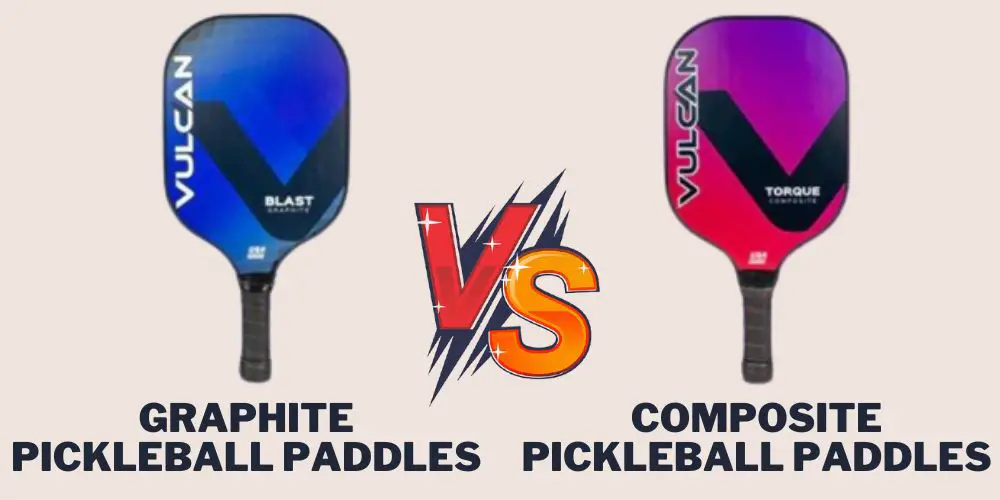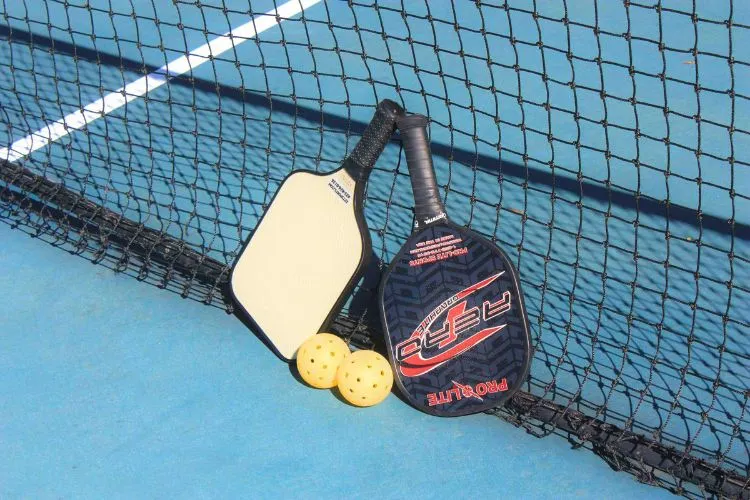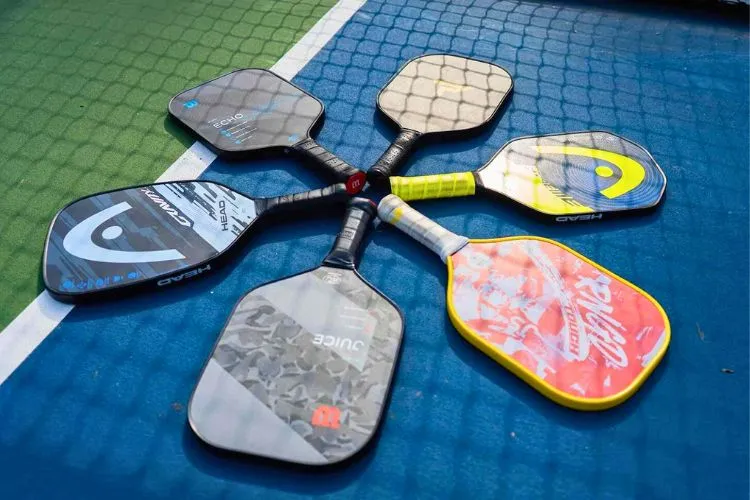Each type of pickleball paddle boast distinct features and advantages that influence how you play the game.
While the lightweight and swift graphite paddles facilitate quick movements, composite paddles impress with their durability and powerful hits.
However, amidst all talks regarding the graphite vs composite pickleball paddles debate, the most crucial distinction lies in the weight-to-performance ratio.
This attribute significantly affects your gameplay, making it essential to understand before making your paddle choice.

Join us as we delve into the nitty-gritty of these two leading paddle options.
Graphite vs Composite Pickleball Paddles: A Comprehensive Comparison
The two most popular materials in pickleball paddle manufacturing are graphite and composite.
This article provides an exhaustive comparison between graphite and composite pickleball paddles, focusing on the key areas of difference between the two.

Weight
One significant area of distinction between graphite and composite paddles is in terms of weight.
Graphite paddles tend to be lighter, usually weighing between 6 to 8 ounces. This lightness is attributed to the thin layer of graphite used to coat the paddle’s surface, thus reducing the overall weight.
A lighter paddle allows for quicker hand movements and swift reactions, which can be beneficial in moves that require speed and precision.
Composite paddles, on the other hand, are noticeably heavier, typically weighing between 7.5 to 9 ounces.
The additional weight is because of the composition of the paddle, which often includes a combination of materials such as fiberglass, aluminum, and polymer. A heavier paddle can pack more power behind every swing, which ultimately can add extra oomph to your shots.
Comfort and Feel
The comfort and feel of your pickleball paddle are critical factors, dramatically affecting your gameplay skills and overall enjoyment.
These aspects can be determined by several features of the paddle, such as its grip size, balance, and maneuverability. An exploration of these elements in both graphite and composite paddles paints a vivid picture of their relative comfort levels.
Grip Size: In pickleball paddles, grip size refers to the circumference of the handle. It plays a pivotal role in both paddle control and player comfort.
Both graphite and composite paddles offer a range of grip sizes to accommodate different hand sizes and preferences. Smaller grip sizes promote better wrist action for improved spin control, while larger grips provide stability and power. It’s essential to try different grip sizes to find the most comfortable fit.
Balance: Balance is about the weight distribution of a paddle. Balanced paddle weight plays a significant role in controlling the ball and manipulating shots.
Graphite paddles, being lightweight, are generally easy to handle and provide a good balance that supports quick reactions and precise control. This can promote faster play and swift hand movements, giving players an upper hand in fast-paced games.
Composite paddles, being heavier, have a different kind of balance. The added weight gives players more stability. It helps to drive the ball with power and can improve the paddle’s stability during swings.
Hence, players who prefer a controlled, powerful play may prefer the balance offered by composite paddles.
Maneuverability: Maneuverability is about how easily you can move the paddle for different kinds of shots. A good maneuverable paddle allows you to make swing adjustments quickly.
Graphite paddles offer excellent maneuverability due to their light weight. This makes them an ideal choice for players who rely on quick reflexes and enjoy a fast-paced game.
Composite paddles, though heavier, can still provide good maneuverability, especially for power hitters. Here, the greater weight can be a benefit as it helps add power to your swings.
In conclusion, the comfort and feel of graphite and composite pickleball paddles can vary significantly. Your choice should depend on your individual comfort preferences, playing style, and hand size. Trying out both types and analyzing their comfort and feel before purchasing can help you make the most informed decision.
Cost
Another area of differentiation between these paddle types is the cost. Graphite paddles are generally more expensive than composite paddles. This increased price is attributed to the cost of the raw materials and the manufacturing process required to produce graphite paddles.
Composite paddles, meanwhile, offer more cost-effective alternatives. This is due to the relatively cheaper materials and manufacturing process.
Even so, it must be noted that among composite paddles, there is significant price variance depending on the specific materials used. For example, composite paddles that include high-end materials like carbon fiber will likely cost more than those with standard fiberglass.
Performance
The performance difference between graphite and composite paddles lies in their ‘sweet spots’. The sweet spot refers to the area on the paddle where you get the most power and control.
Graphite paddles have a consistent sweet spot across the face due to their even, smooth surface. The precision offered by this uniform surface provides players with the ability to execute accurate shots from anywhere on the paddle.
In contrast, composite paddles have a more significant sweet spot. The blend of materials used in their construction enhances the surface’s roughness, resulting in more spin on contact with the ball. This added spin can, in turn, lead to more tricky shots, potentially disorienting opponents.
Durability
Graphite paddles are notably durable, thanks primarily to the high-strength-to-weight ratio of the graphite material. These paddles can endure vigorous play and harsh weather conditions without showing significant wear or tear.
Composite paddles also offer good durability, primarily if high-end materials like carbon fibre are used. However, composite paddles with basic fiberglass may not be as long-lasting as graphite paddles, especially on frequent use.
while graphite and composite pickleball paddles hold their unique advantages, your choice depends on your personal playing style and budget. Graphite paddles are suitable for players who appreciate lightness, quickness, and a consistent sweet spot.
Conversely, composite paddles are ideal for those looking for extra power, an increased sweet spot, and potential cost savings.
In essence, understanding the nuances between the two types will allow you to make an informed decision tailored to your pickleball needs, thereby improving your overall performance in the game.
How do I know what pickleball paddle to use?
When it comes to choosing between Graphite and Composite pickleball paddles, it essentially comes down to weighing the pros and cons of each type based on your style of play, skill level, and personal preference. Here’s what you need to consider:

- Weight & Feel: Graphite paddles are usually lighter (6-8 ounces) compared to composite paddles. So if your gameplay demands swift hand movements or you simply prefer a lighter feeling, graphite could be your best bet. On the other hand, composite paddles usually weigh more (7.5-9 ounces) and may suit players who want to deliver heavier, more powerful hits.
- Control & Power: Graphite paddles generally offer enhanced control and accuracy thanks to their even and smooth surface, with a consistent sweet spot. Composite paddles, being heavier, ensure greater power. Also, their sweet spot tends to be more generous due to the blend of materials used.
- Durability: Both types are fairly durable, but graphite paddles have an edge here. However, if a composite paddle uses high-quality materials like carbon fibre, it can be just as durable.
- Budget: Graphite paddles generally cost more due to their manufacturing process and materials. Composite paddles offer a budget-friendly alternative, without being too far behind in terms of performance and durability.
In summary, if quick, precise control and lightweight equipment suit your style, then graphite paddles may be the way to go. If you value power, more generous sweet spots, or are on a tight budget, a composite paddle could serve you better. It’s all about finding the best fit for your unique needs and play style.
Conclusion:
The choice between graphite and composite pickleball paddles primarily depends on your style of play and budget.
Graphite paddles are lighter, offer excellent touch, and are pricier, making them suitable for intermediate and professional players.
On the other hand, composite paddles, known for their power and durability, are cost-effective, making them ideal for beginners or those seeking to play pickleball on a budget.
Your choice, graphite or composite, should reflect your gaming preference, skill level, and financial threshold.
Ultimately, the perfect paddle is the one that optimizes your strengths and performance on the court.

Pickleball’s more than a game to me—it’s a passion. I write, sharing its highs and lows, the thrills and the lessons. Some tales might draw you to the court, while others give a hint of the game’s magic. So, curious about my journey? Ready to dive deep into the world of pickleball with me? Let’s go.
